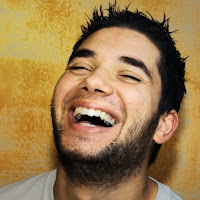We have pretty much known about facial expressions are universal, from the post 'Facial Expressions Are Universal'. Therefore, face is one of key elements of body language commonly shared by you, me and everyone else. The following article is written by Kevin Hogan explaining some of the features and applications displayed by your face.
***
Many experts consider facial expressions the most important non-verbal behaviour of all. Your face is the focal point of conversation and interaction, so the impact of its movements and expressions is magnified. The face is a tool for communicating emotions and feelings, but it is important for regulating and regulating and directing an interaction.
Let's say you are interacting with another person is already talking, your facial expression will change to indicate you want a turn. Your eyebrows rise slightly and your mouth opens as if you are about to speak. Smiling is a facial expression used when listening to someone else as a way of encouraging them, acknowledging what they are saying, and signalling you are interested in what they are saying.
Facial expressions can communicate nearly any emotion you want, the most common being happiness, fear, disgust, anger, sadness and surprise. They are typically appear as follows:
- Happiness – Lips pull back and up at the corners; cheeks raise up; so called crow's feet wrinkles become noticeable on the outside of the eyes.
- Fear – Mouth opens slightly; lips are tense; eyebrows rise up and together; forehead wrinkles in the centre; upper eyelid rises up.
- Disgust – Nose wrinkles up; cheeks raise up; eyebrows lower; upper lip rises up; lower lip may be raised up against the upper lip or lowered slightly and pushed out.
- Anger – Eyes stare with contracted pupils, perhaps seeming to bulge out; eyebrows lower, coming together and creating wrinkles between them; lips may be tense and pressed together or tense and open.
- Sadness – Lips draw down in the corners, perhaps trembling; eyebrows rise up slightly; upper eyelid rises up in the inner corner.
- Surprise – Eyelids open wide; eyebrows arch up; wrinkles appear across entire forehead; jaw drops and mouth opens.
Your face is a useful flirtion device. (It's like a floatation device on an airplane... okay, maybe not.)
A smile, a wink, and raised eyebrows in the right social situation can attract another person's attention and communicate interest. Once a conversation is started, these same facial expressions help to encourage further interest and interaction. The power of facial expressions for attracting and engaging someone else is so big that it can become a misused tool for manipulating or otherwise influencing another person.
There are cultural differences in how facial body language is interpreted as well. For instance, Americans tend to read more emotion into the face than do Japanese. Americans put their focus on the mouth when trying to understand what someone is saying. The Japanese put their attention on the eyes.
People from the same culture are more accurate in reading each other's 'facial expressions, a finding you would expect, of course.
Facial expression can be either deliberate or spontaneous depending on the person and the situation. Children tend to show their facial expressions spontaneously, with little or no deliberate control. Adults, on the other hand, have learned through the years to mask or control certain facial expressions in certain situations where they are considered inappropriate or unwise.
Can you identify the facial expressions in the picture below?


Answers
Top Left: Anger
Top Right: Fear
Middle Left: Digust
Middle Right: Surprise
Bottom Left: Happiness
Bottom Right: Sadness
Can you identify the facial expressions in the picture below?


Answers
Top Left: Anger
Top Right: Fear
Middle Left: Digust
Middle Right: Surprise
Bottom Left: Happiness
Bottom Right: Sadness
Other books by Kevin Hogan






























